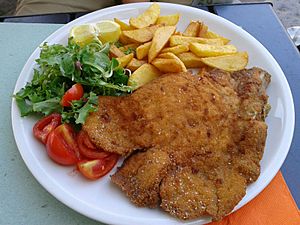Milanesa facts for kids
A milanesa is a popular dish, especially in South America. It's a type of breaded meat cutlet, similar to the Italian cotoletta or the Austrian schnitzel. Imagine a thin slice of meat, coated in breadcrumbs, and then cooked until it's crispy and golden!
This tasty dish came to countries like Argentina, Paraguay, and Uruguay thanks to Italian immigrants. Many Italians moved to South America between the 1860s and 1920s. They brought their food traditions with them. The name "milanesa" likely comes from "cotoletta alla milanese," a dish from Milan, Italy. It's also quite similar to the famous Wiener Schnitzel from Austria.
Contents
How to Make a Milanesa
Making a milanesa is quite simple! First, you take a thin slice of meat. This can be beef, chicken, fish, veal, or even pork. Each slice is then dipped into beaten eggs. The eggs are usually seasoned with salt and other flavors like parsley and garlic.
After the egg, the meat is coated in breadcrumbs. Sometimes, flour is used instead. Finally, the milanesa is cooked. Most people shallow-fry it in oil until it's crispy. For a healthier option, some prefer to bake it in an oven with very little oil. A dish called chicken parmigiana is made in a similar way.
Different Kinds of Milanesa
Milanesas are enjoyed in many ways and in many places. Each country or region often has its own special twist on this classic dish.
Milanesa a la Napolitana
One very popular variation is the milanesa a la napolitana. This dish adds tomato paste, mozzarella cheese, and sometimes ham on top of the cooked milanesa. It's called "Neapolitan" not because it's from Naples, Italy. Instead, it was first made in the 1940s at a restaurant in Argentina called Napoli. This restaurant was owned by Jorge La Grotta. Sometimes, people call it súper milanesa or suprema napolitana.
Milanesa in South America
Milanesas are super popular in Argentina, Paraguay, and Uruguay. They are considered one of the most important dishes in the Río de la Plata region. They are a big part of the legacy left by Italian immigrants. In fact, milanesas are so loved in Argentina that they even have a "Day of the Milanesa" on May 3rd!
Milanesas are often served hot with fried potatoes or mashed potatoes. This meal is known as milanesa con papas fritas or milanesa con puré. In Argentina, Paraguay, and Uruguay, you might find it topped with a fried egg. This is called milanesa a caballo, which means "milanesa riding horseback." Milanesas are also often eaten cold as a sandwich filling, usually with salad. People often add lemon juice or mayonnaise for extra flavor.
Milanesa Kaiser in Chile
In Chile, a version called milanesa Kaiser or escalopa is popular. This one is like a cordon bleu. It has a layer of melted cheese and ham between the beef slices. A classic Chilean version is escalopa a lo pobre. This dish is topped with french fries, cooked onions, and fried eggs.
Milanesa in North America
In Mexico and the Southern United States, milanesas are often eaten as a torta. A torta is a type of sandwich made with special bread like bolillo or telera. In northern Mexican states, it's often served like a traditional sandwich with lettuce, tomato, and mayonnaise. However, it's also a main dish. The memela napolitana is a thick fried tortilla with milanesa, ham, tomato sauce, and grated cheese on top. In Mexico, "milanesa" often refers to the cooking method itself. Any thin, breaded, and fried meat can be called a milanesa. In the state of Nuevo León, milanesa is very popular as a main dish. It's usually served with french fries, refried beans, rice, and a lettuce salad.
Milanesa in Panama
In Panama, milanesas are usually made from thin slices of beef or chicken. Before eating, people often squeeze lime juice over them. They might also add hot sauce. Milanesas are served with white rice and other side dishes like salad, lentils, or beans. When made into sandwiches, they are called emparedado de milanesa or sandwich de milanesa. These sandwiches often include tomatoes, onions, lettuce, ketchup, and American cheese.
Milanesa in the Philippines
In the Philippines, milanesa is known as carne frita. It's cooked in a similar way: meat pounded thin, coated in flour, egg, and breadcrumbs, then fried. It's not as common in restaurants there, but families often make it at home. They usually serve carne frita with white rice, a bean stew (like fabada), and sometimes potato salad. Chili ketchup or a mayo-ketchup sauce (like the South American salsa golf) are also popular additions. It's almost never served as a sandwich in the Philippines.
Milanesa in Poland
In Poland, a similar dish is called Kotlet schabowy. This is a pork loin that's pounded thin, coated in flour, egg, and breadcrumbs, then fried. There's also Kotlet drobiowy made from chicken or turkey, and Kotlet wolowy made from beef. Beef kotlet is often soaked in milk to make it tender. Polish kotlet is traditionally served with cooked potatoes, mashed potatoes, fries, Silesian dumplings, or rice. Common side salads include mizeria (cucumber salad), grated carrot salad, or Ćwikła (beetroot salad). The history of the Polish Kotlet goes back to the 19th century.
See also
 In Spanish: Milanesa para niños
In Spanish: Milanesa para niños





